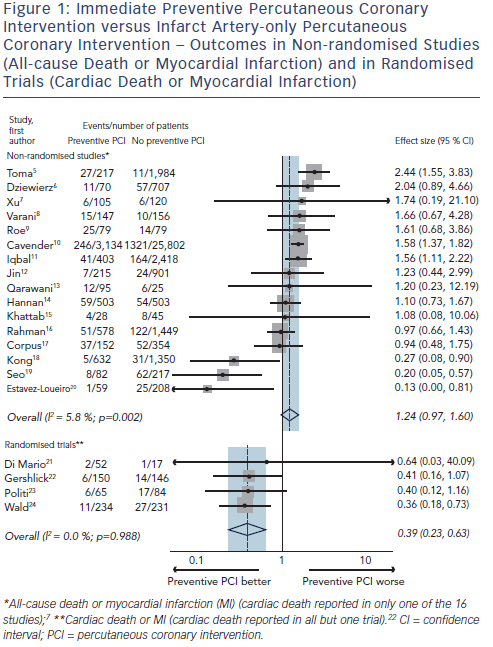This recommendation was based on non- randomised studies in which the outcome of patients with STEMI and multivessel disease who received immediate preventive PCI at the time of their infarct artery PCI was compared with the outcome of patients treated by infarct artery PCI alone. In these studies, doctors determined who received preventive PCI and who did not. Figure 1 shows a metaanalysis plot of 16 such studies (42,817 patients, median follow-up 12 months).5–20 The summary estimate in the non-randomised studies is not statistically significant but suggests a possible increased risk of all-cause death or non-fatal MI in the preventive PCI group (odds ratio 1.24, 95 % confidence interval [CI] 0.97–1.60; p=0.085). The use of all-cause rather than cardiac death as an outcome is a limitation, because it includes non-cardiac causes that are not influenced by PCI (e.g. cancer) and dilutes the relevant cardiac outcomes, but only one study7 reported cause-specific death. A more serious limitation, in the non-randomised studies, is selection bias: the extent to which patien ts who received preventive PCI, for example, were sicker than those receiving infarct artery-only PCI and were therefore heading for a worse outcome regardless of the treatment strategy adopted. Selection bias is not avoided by increasing study size or by adjusting for confounding, because not all confounding factors are measured or known, so even in large propensity score-matched studies11,14 it is not possible to be sure which treatment is better. Selection bias is avoided in a randomised trial, since the use of preventive PCI is determined by random allocation rather than physician choice. Four such trials (979 patients, median follow-up 18 months),21–24 in which cardiac deaths were reported in all but one23, have been completed and a meta-analysis plot of these trials is also shown in Figure 1. The relative risk of cardiac death or non-fatal MI is 0.39 (95 % CI 0.23–0.69; p<0.001), showing that selection bias is an important source of error in the non-randomised studies and indicating that preventive PCI, performed as an immediate extension of the infarct artery PCI, reduces the risk of cardiac death and MI by about 60 %.
ts who received preventive PCI, for example, were sicker than those receiving infarct artery-only PCI and were therefore heading for a worse outcome regardless of the treatment strategy adopted. Selection bias is not avoided by increasing study size or by adjusting for confounding, because not all confounding factors are measured or known, so even in large propensity score-matched studies11,14 it is not possible to be sure which treatment is better. Selection bias is avoided in a randomised trial, since the use of preventive PCI is determined by random allocation rather than physician choice. Four such trials (979 patients, median follow-up 18 months),21–24 in which cardiac deaths were reported in all but one23, have been completed and a meta-analysis plot of these trials is also shown in Figure 1. The relative risk of cardiac death or non-fatal MI is 0.39 (95 % CI 0.23–0.69; p<0.001), showing that selection bias is an important source of error in the non-randomised studies and indicating that preventive PCI, performed as an immediate extension of the infarct artery PCI, reduces the risk of cardiac death and MI by about 60 %.
How can these findings be reconciled with the view that PCI improves symptoms but not prognosis?25–27 The value of angioplasty has been studied in different groups of patients with coronary artery disease. The evidence of benefit in reducing the risk of cardiac death and MI in patients with STEMI is known.1 In patients with non-STEMI, there is a short-term hazard but a long-term benefit.28 In patients with stable angina, prior studies have shown no evidence of prognostic benefit.26–27 This gradation of effect may, at least in part, be due to the fact that PCI causes adverse cardiac events as well as preventing them, and in a lower-risk group, for example, in patients with angina rather than a MI, the benefit may not outweigh the harm.
In patients with STEMI, coronary artery plaque rupture remote from the infarct artery has been demonstrated in autopsy29,30 and intravascular ultrasound studies,31–34 which suggess that plaque instability is not a localised vascular event but a generalised process throughout the coronary tree. In an angiographic study of 253 patients with STEMI, the finding of multiple complex coronary artery lesions (>50 % stenosis) remote from the infarct artery was associated with a 10.6-fold excess risk of recurrent acute coronary syndrome within 1 year.35 The simplest, albeit speculative, explanation for the preventive benefit of PCI in such patients is by stabilising plaques prone to rupture and spontaneous thrombosis,36 so reducing subsequent infarction. There is uncertainty whether the benefit outweighs the risk of PCI in stenoses <50 %, since these were not included in the randomised trials. Preventive PCI may also reduce ischaemia by improving coronary flow in severe stenoses and by preventing progression over time, explaining the observed reduction in refractory angina. The concordance between the components of the primary outcomes in Preventive Angioplasty in Myocardial Infarction (PRAMI) (hazard ratios 0.34 [0.11–1.08], 0.32 [0.13–0.75] and 0.35 [0.18–0.69] for cardiac death, non-fatal myocardial infarction and refractory angina, respectively)24 suggests that both mechanisms may be similarly important in the prevention of future cardiac events.